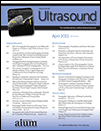Role of Sonographic Elastography in the Differential Diagnosis of Axillary Lymph Nodes in Breast Cancer
Abstract
Objectives
The purpose of this study was to evaluate the diagnostic utility of sonographic elastography in differentiating reactive and metastatic axillary lymph nodes in breast cancer.
Methods
A total of 64 lymph nodes (reactive, n = 33; metastatic, n = 31) from 62 patients with breast cancer were examined by both B-mode sonography and elastography from April to July 2009. Two experienced radiologists retrospectively assessed B-mode sonograms by the sum of scores for 4 criteria: short diameter, shape, hilum, and cortical thickening. Elastographic images were given scores of 1 to 4 according to the percentage of high-elasticity areas in the lymph nodes. We compared the diagnostic performance of B-mode sonography, elastography, and combined examinations. We also calculated the strain ratio of the lymph node and subcutaneous fat tissue.
Results
The elasticity score for malignant lymph nodes (mean, 3.1) was higher than the score for benign lymph nodes (mean, 2.2; P < .0001). With a cutoff between elasticity scores of 2 and 3, elastography showed 80.7% sensitivity, 66.7% specificity, and 73.4% accuracy. With a cutoff between B-mode sonographic scores of 1 and 2, B-mode sonography showed 74.2% sensitivity and 78.8% specificity. Combined B-mode and elastographic sonography showed higher sensitivity (87.1%) than B-mode sonography alone. With a strain ratio cutoff point of 2.3, sensitivity was 82.8%, and specificity was 56.3%.
Conclusions
Sonographic elastography may increase the sensitivity of B-mode sonography in the detection of metastatic axillary lymph nodes.




